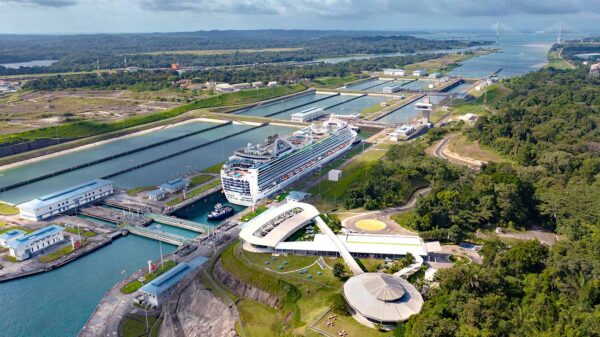Panama Canal, a pillar of Panama’s tourism industry
The Panama Canal is one of the pillars of the country’s tourism industry; it is one of the first places […]
The Panama Canal is one of the pillars of the country’s tourism industry; it is one of the first places on the agenda of tourists arriving in Panama. For this reason, the Panamanian administration of the waterway has undertaken a project to modernize the Visitor Centers at its Atlantic and Pacific terminals.
The Miraflores Visitors Center, on the Pacific side, began construction in 2000, just after the Canal was transferred to Panamanian hands, and was inaugurated in 2003.
On the other hand, as part of the Expansion Program (2007-2016), the Visitor’s Center at the Agua Clara Locks was built parallel to the Neopanamax locks in Colon. A pavilion was added in Cocolí (Pacific); and in August 2019, the Santiago Interactive Center (CIS), in the province of Veraguas, was inaugurated.
Prior to the pandemic, the average number of visits to the Centers was almost one million per year, at a rate of 3,000 per day. On January 28, 2019, on the occasion of the World Youth Day (WYD) celebration in Panama, a record was set with 9,200 visits (8,400 at Miraflores and 800 at Agua Clara).
“The Canal Visitor Centers represent a great contribution to the national tourism industry, since every national or foreign tourist who comes to Panama, wants to go to the most visited place in the country, the Canal, which is an icon, and at the Atlantic and Pacific Visitor Centers, they have the opportunity, not only to see the transit of ships through the locks, but also to learn about the history and operation of the Panamanian waterway,” says Jaime Troyano, a guide at the Centers.
Following the Canal’s fiscal calendar that starts in October and ends in September of the following year, between October 1, 2019 and March 15, 2020, when they were closed due to the pandemic, the Canal Visitor Centers had received 205,449 tourists. Now reopened, the Centers have 116,108 visitors so far in fiscal year 2022 (October 1, 2021 – January 31, 2022), at a rate of 239 people per day.
Visitor numbers in pre-pandemic years
| 2014 | = | 978,342 |
| 2015 | = | 964,692 |
| 2016 | = | 980,466 |
| 2017 | = | 957,773 |
| 2018 | = | 906,552 |
| 2019 | = | 911,792 |
Hand in hand with Camtur

The administration of the Canal Visitor Centers maintains a close relationship with the other players in the industry, and this is recognized by the Panama Chamber of Tourism (Camtur), whose new board of directors, chaired by Ovidio Díaz, intends to make the most of this alliance.
“The Canal is the most important tourist product we have… it has sold very well. Who doesn’t know Panama for its Canal?” says Diaz, a hotelier from the province of Los Santos, who goes on to say that “more people know Panama for its Canal”, which he considers to be the “great bait” that attracts foreign tourists. “You throw out that bait, and you have to be sure you’re going to catch fish,” he stresses.
Sun and beach, need more rooms
Díaz affirms that the country’s number one tourist offer is “sun and beach”, and it is in the interior of the country. However, it requires greater private investment for the construction of more rooms, because it has a very limited offer. The other attraction, with 20,000 rooms, is Panama City, “it is for us to go out and look for the tourism and events industry”.
He highlights that the Panamanian capital also has a first-world international airport, excellent connectivity, a cruise port close to full operation, world-class convention centers such as Amador and Atlapa, which should be incorporated back into the tourism offer to add thousands of square meters of areas suitable for holding events in the private sector.
“For example, if you come to hold a four-day congress, you take hours out of that agenda and take them to the Canal, to meet the Emberá people on the banks of the Chagres River; to Taboga or Casco Antiguo. It is a perfect complement for Panama City to become the number one meeting center in Latin America, because we have everything to achieve it,” says the hotelier.
Future plans
We have great challenges in our management, but they are achievable, because tourism is like the Panama Canal: it is an industry that works and generates a lot of income for the country, it is a very noble industry with great economic spillover, which gives opportunities to everyone.
You can become a tourist entrepreneur tomorrow if you want to, for example, rent umbrellas on the beaches; that does not exist. There you go, you invest little and you become a small businessman; that is tourism. That’s why I took on the responsibility of chairing the board of directors of the Panama Chamber of Tourism (Camtur), which brings together 16 tourism associations from all over the country.
“I am extremely optimistic, because I know we are going to make it. Having been born and raised in the interior of the country, in addition to my education, gives me a very clear understanding of the capacity we have to exploit our resources,” Díaz emphasizes.

Dynamics after reopening during the pandemic
With the reopening of the Canal’s Visitor Centers in 2021 (Agua Clara, on May 15 and Miraflores, on August 11) after having been closed since March 16, 2020 due to the pandemic, visits are from Tuesday to Sunday, from 8:00 a.m. to 5:00 p.m., through the Canal’s Visitors Centers. – 5:00 p.m. through reservations at the electronic link: https://visitcanaldepanama.com/.
Likewise, the use of masks, the physical distancing, the use of alcohol gel and the constant washing of hands is mandatory, both for visitors and for the personnel working in these facilities.
Upon arrival at the Visitor Center, tourists present their digital reservation at the ticket office, where they are given a physical ticket to enter the facilities.
In the case of Miraflores, the exhibition halls operate partially, with an expedited passage to reach the fourth floor viewpoint, where guides provide information on the history and operation of the Canal. Then descend and go to the lower terrace, first floor, where a store operates. All in one hour and 15 minutes. Very similar is the dynamic at the Agua Clara Center.
In this way, the Panama Canal offers a privileged and safe view of the interoceanic waterway, both to domestic and foreign visitors, with the purpose of disseminating its history, present and future.